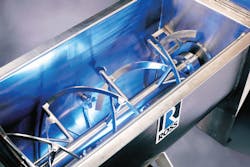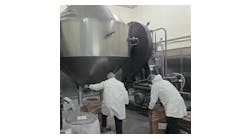Many mixer designs are available in the market, from off-the-shelf and industrial models to highly customized equipment marketed to specific food submarkets. Equipment selection can be a daunting task, especially when cash flow is critical and uncertainties — because of market fluctuation, strong competition or lack of experience — are at play.
Serving as a quick, guided introduction to specialty mixing equipment, this article highlights two main technologies used by many established food producers that small and medium-sized companies might consider adopting to expand operations. These mixers are natural starting points when gearing up to grow to the next level.
Ribbon blenders
Image 2. Large-scale ribbon blender with reinforcing bars to provide structural support to the horizontal trough. | Click to view larger
The classic ribbon blender is used throughout the food industry for the fast and straightforward mixing of powders, granules and other solid forms. This style of blender consists of a U-shaped, horizontal trough and an agitator made up of inner and outer helical ribbons pitched to move material axially in opposite directions as well as radially. The ribbons rotate at tip speeds up to around 300 feet per minute (fpm).
Arguably, no other piece of equipment is more efficient and economical for mixing a wide variety of applications than the ribbon blender. Typical applications include cake mixes, flour blends, bread improvers, trail mixes, granola, snack bars, spices, herbs, seasonings, sweeteners, frozen vegetables and food supplements. Ribbon blenders also are used to blend tea leaves; whole or ground coffee beans; and beverage formulations – such as protein shakes, iced tea mixes, chocolate drinks, powdered juices and energy drinks.
In batching these kinds of products, relatively small amounts of liquid are sometimes added to the solids to coat or absorb flavoring, coloring, oils or other minor additives. Liquid ingredients can be poured through a charge port on the cover while the blender is running. However for critical applications, liquid addition is best accomplished with spray nozzles installed in a spray bar located just above the ribbons to ensure uniform application at a controlled rate.
Although dry blending is its most popular function, the ribbon blender also is used in the preparation of slurries or paste-like foods – such as cake batter and extruded foods like pasta, cereals, chips and other snacks. In a food extrusion operation, the ribbon blender creates a homogeneous mix of grain, flour, oil, sugar, emulsifiers, extrusion aides and other ingredients. Once they are blended, water may be added to the batch to raise the moisture content to the proper level for extrusion.
Another category of products routinely batched in large volumes in a ribbon blender are discrete solid particles suspended in liquid or surrounded by a wet medium. Examples include guacamole, egg salad, chicken salad and other sandwich fillings, meat or pasta with sauce, vegetable soups, and wet pet foods to name a few.
Some tips for ribbon blender selection are described below:
- Proper sizing is extremely important. Batch volume (not mass) defines the size of the ribbon blender, but bulk density determines the right horsepower. Most standard-duty agitator shafts and spokes are recommended for bulk densities up to 35 pounds per cubic foot. Denser products will require a heavy-duty blender. Running an overweight batch on a light-duty ribbon blender, even when the product level (volume) is below maximum, could overload the motor or lead to more serious mechanical failure. For this reason, accurate bulk density must be determined for the full range of recipes that will be batched in a ribbon blender.
- Do not underfill the blender. Optimal mixing in a ribbon blender requires enough batch material – at least 30 to 40 percent of the rated volumetric capacity. When working with smaller volumes, the blender may fail to generate adequate contact between the agitator and batch materials.
- In most cases, a variable frequency drive (VFD) is recommended versus a simple motor starter. The VFD will enable a safe, slow start under full load and protect the system against a spike in startup torque. An electronic soft starter will work in a similar way but enable only single-speed operation. Variable speed is beneficial during mixing and discharge cycles.
- The most reliable drive design for a ribbon blender is a one-piece motor reducer or gearmotor. This direct-drive arrangement is cleaner and more compact when compared to chain and belt drives. It also reduces noise in the plant and eliminates maintenance headaches. Gearmotors are designed to work well with VFDs.
- To minimize dust, make sure blenders have dust-tight discharge valves and clamps to secure the gasketed cover. Upgrade to a flush-bottom ball valve if the blender needs to be liquid tight.
Image 3. Examples of batchstyle, high-shear mixers: basic model suitable for mounting to a tank (left); rotor/stator mixer supplied with an air/oil hydraulic lift (center); all-stainless steel mixer, hanging bracket, mobile lift and tank (right). | Click to view larger
High-shear mixers
Food manufacturers rely on a variety of high-speed mixers to accomplish processing objectives like emulsification, powder dispersion, dissolution and homogenization. One of the most versatile machines for these purposes is the high-shear mixer, also referred to as a rotor/stator mixer. The basic, single-stage design features a four-blade rotor that turns at tip speeds of approximately 3,000 to 4,000 fpm within a close tolerance-fixed stator. It creates mechanical and hydraulic shear by continuously drawing product components into the rotor and expelling them radially through the openings in the stator. This induces intense turbulence and generates small droplets in an emulsion, disintegrates soft solids or quickly homogenizes a mixture.
Food companies use high-shear mixers most often to produce sauces, salsas, sandwich spreads, dressings, condiments, flavor emulsions, syrups, oils, juices, fillings, gravies, gels, marinades, glazes and other products. Rotor/stator mixers are available in batch (top-entering) and inline (continuous/recirculation) configurations.
In traditional mixing stations, bulk powders – such as milk, cocoa, whey or sugar – are slowly poured into an open vessel while liquid is agitated. This method can be time-consuming and, despite great care, even release significant amounts of airborne particles that require lengthy cleanup. On the other hand, ingredients like gums and thickeners, while added in much smaller amounts, need constant agitation over long periods to dissolve completely. In short, operators engage in a tough balancing act to efficiently batch a lump-free, finished product within a reasonable cycle time.
New generation rotor/stator mixers capable of injecting powders subsurface, such as the all-stainless steel mixer in Image 3, address this issue. They offer a technique for adding solids that minimizes lump formation and shortens mix time without relying on eductors or external pumps. The best applications for powder induction include a wide range of food products and intermediates. Notoriously difficult ingredients— such as xanthan gum, carrageenan, guar gum, alginates, cellulose gum, pectin, gum arabic and starch— are immediately wetted out and dispersed into liquid with none of the typical issues: no floating powders, “fish eyes” or stubborn agglomerates, excessive dusting and foaming, or overly long mix times.
An inline high-shear mixer designed for powder induction offers a neat solution by pumping liquid from a tank while simultaneously drawing powders from a hopper (or straight out of their original container). As the liquid stream enters the rotor/stator assembly, it immediately encounters the powder injection under high-shear conditions (see Image 4).
The resulting mixture is pumped by the mixer back to the tank and recirculated until dispersion is complete. An optional, operator-friendly workbench can improve material handling (see Image 5). The workbench makes handling bags of raw materials during the mixing cycle easier for operators. Unlike older powder induction systems, the modified rotor/stator mixer offers a compact design that does not require the use of a centrifugal pump, eductor or vacuum pump to create suction. This makes it less sensitive to changes in flow and viscosity, easier to clean, and simpler to maintain. Throughput is dramatically higher as well.
Some tips for high shear mixer selection are:
Image 5. A 25-horsepower, high-shear mixer designed for powder induction with built-in control panel and mounted on a portable cart for servicing multiple vessels of virtually any size located anywhere on the plant floor. | Click to view larger
Conclusion
Trial/rental programs offer a way for manufacturers to determine if a certain mixer is the right choice before a large capital expenditure. Visiting a testing facility to run a demo mixer and complete a batch or two using actual raw materials is even better. Some testing laboratories allow unwitnessed simulations, but the manufacturer’s expertise on the characteristics and properties of specific products will boost the trial’s chances for success. Plus, this allows observation of how the mixer operates and a chance to learn useful techniques and identify any potential issues well before the equipment is delivered. Ask about optional features that could help increase productivity, lower operating costs and simplify cleaning.
Christine Banaszek is an application engineer at Charles Ross & Son Company, manufacturer of specialty mixing equipment, and a member of the Processing Editorial Advisory Board. She received a Bachelor of Science degree in chemical engineering from the University of the Philippines, Diliman, where she also served as an instructor of chemical and environmental engineering. She has published many articles and white papers on mixing and blending technologies, applications and best practices.








